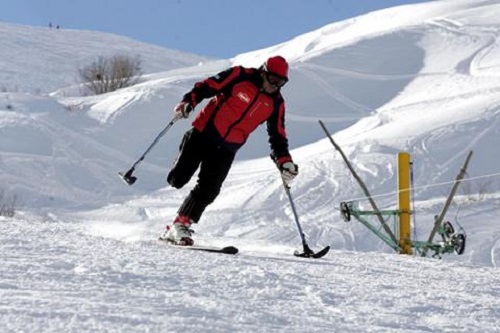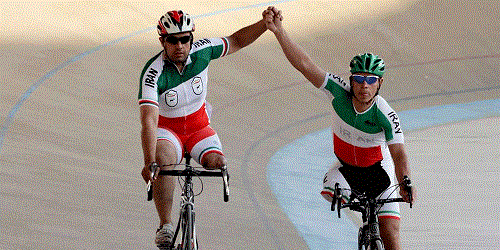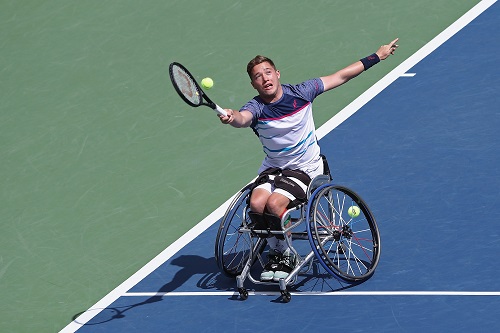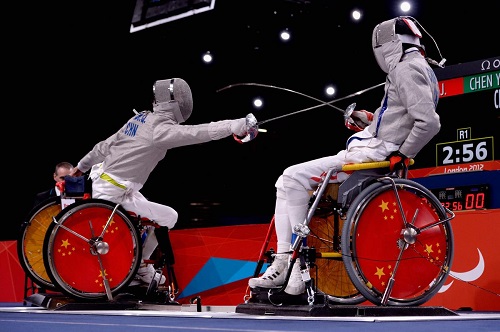| |
Alpine skiing
Sports for the disabled
Alpine skiing
Alpine skiing for athletes with a disability has been on the Paralympic program since the first event in 1976. Two alpine skiing events (slalom and giant slalom) were held at the first Paralympic Winter Games in Ornskoldsvik, Sweden, in 1976. In 1984, Downhill skiing was added, and super-G added in 1994.
Up until 1998, the alpine skiing events were only for standing classes. Events for seated skiers (mono-skiing) were introduced at the Nagano 1998 Paralympic Winter Games.
For the 2014 Games, Para-snowboard was introduced as a discipline of alpine skiing, and became a separate sports category for 2018.
This field was launched in Iran in 1998 and its first overseas game was in the Winter Paralympics in Nagano, Japan in 1998.
.

Archery
Para-Archery first game to light in 1948 at Stoke Mandeville Hospital to aid recovering veterans, after World War II. The competition has featured in every Paralympic games, since they began back in 1960.
Para-Archery is open to a number of athletes who have a physical impairment, there are currently three different classifications. It is an individual and a team sport, which involves both standing and wheelchair events, open to both men and women.
Athlete’s shoot from a distance of 70m at targets marked with 10 scoring zones. In both the individual and team events the first round ranks the athletes, before the elimination process begins. Athletes/teams go head to head, and in the event of a tie, a shootout decides the winner.
A notable competitor who goes by the name of Danielle Brown has recently made history for herself. After winning her first gold in the individual compound event at the 2008 Beijing Paralympic games, Danielle went on to compete in the 2010 Commonwealth games. Here she made history as the first disabled athlete to represent Team England, and she also won gold. Danielle returned to Para-Archery in the London 2012 Paralympic games to defend her title, where she saw gold again.
This field was launched in Iran in 1994 and its first overseas game was in the England in 1995. At London 2012, Nemati set a Paralympic record on her way to gold in the women's individual recurve W1/W2, and she also picked up a bronze medal in the women's team recurve open.
Boccia
Boccia is a ball sport, which has similarities to bocce, bowls, and pétanque. Athletes with physical disabilities contest Boccia. This sport can be played between individuals, between pairs, or between groups of three.
The goal of the game is to throw leather balls to a white target ball, which is also called jack. The first ball, which is thrown, is the jack, and then followed by two regular balls. After this, whoever is furthest away from the jack will be having the opportunity to get closer to the jack, or they can knock the opponent's ball out of the way.
The athletes can move the ball using their feet or their hands, if they are severely disabled, they can use an assistive device like a ramp.
The referee will be the one to measure the balls closest to the jack at the end of each round. One point is given to the team for every ball that is closer to the jack than the opposing team's ball.
This field was launched in Iran in 2004 and its first overseas game was in the Asia-Pacific Malaysian Pacific Championship in 2006.
Cycling
Cycling has quite a history at the Paralympics. It was first introduced in the 1984 Paralympic games, in New York. It included only road events for athletes with cerebral palsy. At the next Paralympic games, Seoul 1988, athletes with visual impairments only, competed. At Barcelona 1992, more impairment classes were included. Then, at Atlanta 1996, track events were finally added to the program.
Cycling is both a track and road event sport, for men and women. Athletes with physical and visual impairments can now compete, thanks to the sport adapting and growing over its initial 12 years.
Paralympic athletes compete under the same rules and regulations that are implemented in the Olympic Games.
According to an athlete’s impairment, they race on either a bicycle, tricycle, tandem or hand cycle. They can compete in sprints, time trials, or road races in individual or team events. When athletes from different classifications compete against each other, the severity of their impairment is considered. Hence, it is not always the fastest athlete who will win, but the athlete who scores the best after all external factors have been take into account.
This field was launched in Iran in 2001 and its first overseas game was in the Germany World Cup in 2002.

Goalball is a team sport designed specifically for blind athletes. The sport was devised back in 1946 to help rehabilitate war veterans returning from World War II. Participants compete in teams of three, and try to throw a ball into the opponents' goal. A match consists of two halves of 12 minutes each. The ball (like in football 5-a-side) has bells embedded in it.
Goalball is played by male and female teams. The athletes wear blackout eye masks on the playing court, which allows players with varying degrees of vision to participate together.
Goalball was a demonstration sport at the 1976 Summer Paralympics in Toronto, and made its debut as an official sport at the Paralympics in 1980. It was the first Paralympic sport designed exclusively for disabled players.
This field was launched in Iran in 1980 and its first overseas game was in the Seoul Paralympic Games in 1988.
Judo
Since the 1988 Paralympic Games in Seoul, Judo has been a competitive sport in the Paralympic program.
The aim of the game is very simple, whoever scores the most points will win the contest. Scores range from 100 to 1, and include the ultimate ippon, waza-ari and yuko. The main objective is the “ultimate ippon”, which is achieved by throwing, holding or submission. If either opponent performs the “ultimate ippon”, they automatically win.
Penalties can also be given to athletes for a number of reasons, such as a foul. Any athlete who receives four penalties in a contest will automatically be disqualified. Hence, their opponent will win.
If both athletes are tied on scores or number of penalties, they will compete in a “golden score” format. There is no time limit, and there first person to score will win.
It is common for athletes that are part of the Paralympic and Olympic team, to combine their training together. This is the case for team GB, as they have an integrated plan.
This field was launched in Iran in 1991 and its first overseas game was in the Spain World Cup in 1998.
Paralympic Football
Athletes with physical or mental disability play Paralympic football. Paralympic football has two common versions i.e. 5-a-side-football and 7-a-side football.
5-a-side football (blind football)
More commonly known as blind football, 5-a-side football is for athletes with a visual impairment as well as blindness. It is played with modified FIFA rules. There are five players in each team including the goal keeper. The field of play is comparatively smaller than the traditional game and is surrounded by boards so the ball remains in play. There are no throw-ins and no offside rule.
Teams utilize a guide positioned off the field of play who can help in directing players, as well as the coach and goalkeeper which are not visually impaired. Being blind, the athletes need a ball with a noise making device so that it can be located due to its sound. The duration is two halves of 25 minutes with a ten minute break half time.
The classification of these players depends on their level of visual impairment. B1 is for those who are totally blind. B2 is for partially blind athletes. B3 is for partially sighted.
This field was launched in Iran in 2006 and its first overseas game was in the South Korea Asia-Pacific Games in 2007.
7-a-side football
7-a-side football is for athletes with cerebral palsy as well as any other neurological disorder such as stroke or some traumatic brain injury. The Cerebral Palsy International Sports and Recreation Association governs this sport. This sport is also played with modified FIFA rules. There is a smaller field of play and there are less players as well along with no offside rule. One handed throw-ins are allowed.
The duration of the match is two halves of thirty minutes each and a fifteen minute half time break in between. The players are given classification based on their level of disability. C5 is for those athletes that have difficulty in walking and running.C6 is for those with upper limb coordination problems. C7 is for those with hemiplegia. C8 is for minimally disabled athletes.
This field was launched in Iran in 1993 and its first overseas game was in 1999 to the International Tournament of Russia Golden Cup.
Racerunning
Racerunning is a track and field racing sport which was developed to be contested by disabled athletes. The sport which is modeled after running races for normal athletes was developed in Denmark in 1961, by a Paralympics athlete Connie Hansen, and Mansoor Siddiqi. Currently, racerunning is practiced by men, women and children of various ages.
For racerunning, athletes use a specially designed tricycle, called the running bike, to aid them during their runs. The running bike has three wheels, with the two rear wheels relatively closer. The bike has a saddle, and a body support on which athletes lean on, while moving forward. There are no pedals in the bike, and the athletes have to use their legs to propel them forward.
Unlike other Paralympic sports, there are no classifications of athletes based on athlete's disability, and only athletes able enough to run using the running bike as a support are allowed to compete.
Similar to regular running races, racerunning races are conducted for short (100m, 200m, 400m), medium (800m, 1500m), and long (5K, 10K, half marathon, and full marathon) distances.
Racerunning is not as popular as some of the other sports for disabled athletes and is currently not a part of the Paralympics. However there are several regional level competitions conducted for racerunning.
This field was launched in Iran in 1980 and its first overseas game was in the Stoke Mandeville World Championships in England in 1983. The first series of colorful medals were awarded during the 1988 Seoul Games.
Shooting
Shooting first made an appearance as a Paralympic sport during 1976 in Toronto. Any athlete with a physical impairment can compete, however no athletes with a visual impairment can partake in the events. The events in Paralympic Shooting are the same as the events in the Olympic programme. Prone events in air rifle shooting have also been included in the Paralympic Games.
Ever since the 1996 Paralympic Games in Athens, classes have been decided on functional ability, as opposed to physical impairments. There are both pistol and air rifle events, which feature athletes shooting from 10m, 25m and 50m distances. Out of the total 12 events, there are three men’s only, three women’s only and six mixed events. Including standing, kneeling and prone position events.
Shooting is an ultimate contest of accuracy and control, athletes compete to shoot as close as possible to the centre of a target, with a number of shots. The target has 10 concentric rings, athletes can score between 1 and 10 by hitting the target, with the outside ring worth 1 and the centre ring worth 10. Depending on which event it is, the targets can come in different sizes. The athlete with the highest score wins.
Athletes compete in a series of qualification rounds, followed by a knockout stage. Eight athletes make it through, but only one can win. Since the games have become increasingly competitive and the margins are so small, it is now possible to score to the nearest decimal, with the maximum score being 10.9.
This field was launched in Iran in 1982 and its first overseas game was in the Stoke Mandeville World Championships in England in 1982. The first men and women were sent to the 1996 Atlanta Games. Enayat Bukharaee was awarded the first men gold medal and Ms. Nayreh Akef was awarded the first women bronze medal.
.jpg)
Sitting Volleyball
Sitting volleyball was first featured in the Paralympic Games as a demonstration sport, at the 1976 Toronto Games. It was then introduced as a medal sport in Arnhem during 1980. The sport first originated in the Netherlands during the 1950s, it was a combination of volleyball and the German Sitzball sport. Initially, standing volleyball was included in the Paralympic program. However, it was discontinued in the 2000 games.
Athletes with any physical impairment can compete in sitting volleyball, and there are both men’s and women’s events. The aim of the game is to hit the ball over the net, and land it in the opponent’s court, without them returning it successfully. Each team can use up to three passes for an attack, then they must hit the ball over the net. To win a set, a team must score 25 points, but they must win by two clear points. It is a best of 5 format, if the contest goes to game 5, then to win, a team must score 15 points, with a 2 point lead.
In comparison to the court and net used for regular indoor volleyball, the Paralympic Games has scaled down these factors. Using a 10m by 6m court, and a lower net. As you would expect, this results in a faster gameplay for the Paralympic sport. Another difference from the Olympic volleyball rules, is that you are able to block an opponent’s serve.
Each team can have 6 players on the court at one time, with 5 athletes in reserve. A defensive specialist can feature in the team as one of the six, who wears a different coloured shirt, to help the team’s performance.
Surprisingly enough, even though the sport is sitting volleyball, not all athletes who compete are unable to stand. You may often see players stand up to celebrate. To be eligible to play, an athlete must not be able to compete in the Olympics due to an impairment, they do not necessarily have to be disabled in their lower body.
This field was launched in Iran in 1980 and its first overseas game was place in the World Championships in Norway in 1984.
Swimming
At the first ever Paralympic Games during 1960 in Rome, there was only eight sports included. Swimming was one of them, and is now one of the most popular. With over 500 athletes, including male and female, in 70 countries around the world, actively competing through a range of events and classifications, it is no surprise that it is so popular.
Swimmers are classified with regards to their functional ability on each stroke, and can compete in freestyle, backstroke, butterfly, breaststroke and medley events. Each race occurs in a 50m pool, the total distances to be covered vary from 50m to 400m.
The events are open to athletes with physical, intellectual or visual impairments. Depending on which classification an athlete is in, there may be modifications such as optional starting platforms or in-water starts. There are a total of 13 different classifications, athletes may fit into different classifications for each event, since their impairment can affect different strokes in different ways. Hence, these classes are known as functional classifications.
The athlete who covers the required distance in the fastest time, wins. There are a series of heats, known as qualification rounds, followed by the finals, in order to decide the winner.
Trischa Zorn is an incredible Paralympian who deserves a mention. Having totalled 32 gold, 9 silver and 5 bronze medals between 1980 and 2004, she is the sports most decorated athlete.
This field was launched in Iran in 1980 and its first overseas game was in the UK international contest for injured military veterans in 1993. The first competition of Iranian athletes took place at the London 2012 Paralympic Games.
Table Tennis at the Paralympic Games
Table tennis has been a part of the Paralympic programme ever since the first games during 1960 in Rome.
There are both sitting and standing events, and the sport is open to both men and women who can compete in individual, doubles and team events. Traditionally, matches are played in a best of 5 format, with a score of 11 points winning each set. To score, athletes must hit the ball over the net into the opponents half, with their opponent failing to return it.
In terms of classifications, athletes are assessed on their functional ability and given a number between 1 and 10. Athletes with the same functional ability number will then compete against each other. There are 5 classes for those in wheelchairs, and 5 for those who are standing. A further 11 classifications are for standing athletes with an intellectual impairment. The tournaments follows a qualification round followed by knockout stages to determine the gold medallists.
This field was launched in Iran in 1980 and its first overseas game was in the Stoke Mandeville World Championships in England in 1985. Its first game was in 1992 Atlanta Paralympic Games for the women's.

Weightlifting
In Tokyo during 1964, weightlifting first featured in the Paralympic Games. Initially, the sport was only for male competitors who had spinal injuries, but it evolved into something much more than that. After its Paralympic debut, the sport included more and more disability groups as the years went on. It also began implementing rules similar to able-bodied weightlifting. Finally, in 1992 at the Barcelona Paralympic Games, weightlifting was officially replaced by powerlifting. In essence, powerlifting is another form of lifting weights.
There was a number of events that took place in the weightlifting sport every year, and they were separated by weight class. The classes ranged from 48kg all the way up to 100kg. Weightlifting was essentially a test of pure strength, power and control. Athletes that were competing had to lower a loaded barbell to their chest, hold it, and explode back up. They followed this routine under the referee’s commands. Each athlete had up to 3 trials for the lift, and they chose their own weight. The athlete who could bench press the most weight won the gold medal.
While the sport did transition from weightlifting to powerlifting, not much actually changed. The rules and regulations evolved, as with every sport, but at the heart of the sport remains the attributes of pure strength and power.
This field was launched in Iran in 1986 and its first overseas game was in the Seoul Paralympic Games in 1988. The first gold medal was awarded during the 1996 Atlanta Paralympics.
Wheelchair Basketball
Wheelchair basketball is basically regular basketball played while sitting on a wheelchair. This sport is mostly played by disabled people and wheelchair basketball is one of the major disabled sports which is practiced. The game dates back to the 1940's.
This field was launched in Iran in 1980 and its first overseas game was in the former Yugoslavia in 1981. In 2004, Athens was the first game of the Iranian wheelchair basketball team in the Paralympic Games.
Wheelchair Fencing
Wheelchair Fencing is another sport that was born post-World War 2. Sir Ludwig Guttmann of Stoke Mandeville Hospital was the first to introduce it, with the goal of encouraging physical strength and self-respect amongst injured soldiers. It was during 1960 at the first Paralympic Games in Rome, where wheelchair fencing made its debut, alongside only 7 other sports.
Both male and female athletes, with spine injuries, lower limb amputations or cerebral palsy are eligible to play. Athletes who need the use of a wheelchair can also compete. There are classifications for athletes, which refer to aspects like sitting balance and amputations.
Initially, the events follow a group stages format, and the top athletes move on to the knockout stages. In the actual head to head ties, each fencers’ wheelchair is attached into medal frames on the floor, allowing only upper body movement. Athletes cannot move back or forth, but have total upper body control.
Fencers must strike their opponent in the correct area, using their sword that is attached to electronic equipment. There are a total of three events in the sport, they all differ according to the sword used, the foil, the epee and the sabre.
In the group stages, contests last up to 4 minutes, the first fencer to register 5 hits automatically wins. In the knockout stages there are 3, 3 minute rounds. The aim is to register a total of 15 hits.
China is a force to be reckoned with in this sport. They have asserted their dominance in both world championships and the Paralympic Games themselves.

Wheelchair Tennis
Wheelchair tennis is a version of lawn tennis which was developed to be played by those who have lower body disabilities. The sport came to life in 1976 and was first adapted by France. It is currently practiced in several countries around the world.
Wheelchair tennis is played on the same courts that are used for playing lawn tennis. The rackets and balls used are also exactly the same. The only difference is that, athletes move around the court on specially designed wheelchairs.
The game play consistsing of serves and returns, and the scoring, are exactly the same as regular tennis. The only major difference is, it is legal for the ball to bounce twice before it is returned. The second bounce is accepted as valid even if it happens outside the court as long as the first bounce happens in the fair territory.
Like regular tennis, there are two separate categories for men and women. There is also a third category known as Quad, where rackets can be taped to players hands and are allowed to use wheelchairs that are electric powered.
Wheelchair tennis is played during all the four Grand Slams. It is also contested during the Summer Paralympic Games.
This field was launched in Iran in 1995 and its first overseas game was in the Asia-Pacific Malaysia Championships in 1999.

|